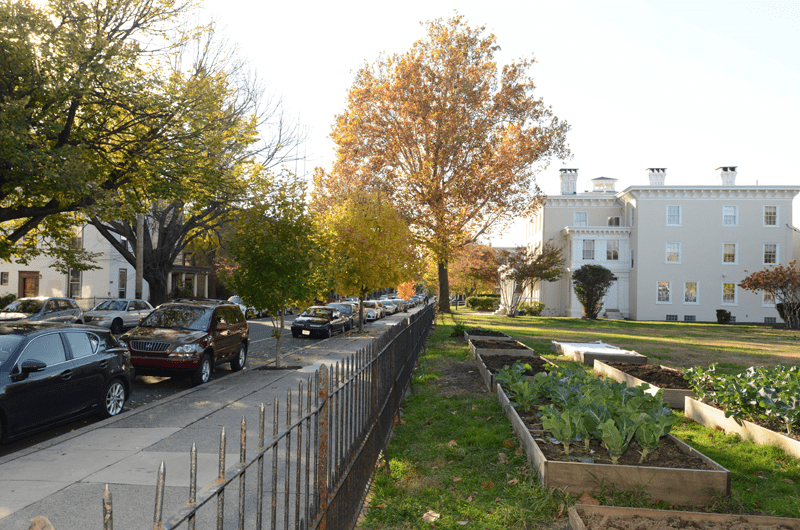A Natural Match: Drexel Research Team Connects Urban Design to Public Health
 By Rachel Ewing
By Rachel Ewing

As inner-city school kids climb and swing at a state-of-the-art playground with a rain garden and trees, will their surroundings make a difference in their health and social well-being? At urban community gardens nearby, will the fresh produce and a greener view help local residents breathe easier?
Such questions, connecting urban design and natural systems with public health, are the focus of a new convergence of research and community engagement efforts at Drexel. A new team of faculty from the School of Public Health and Westphal College of Media Arts & Design is bringing together research on these interdisciplinary questions within community-based projects in West Philadelphia—some of which are already underway, and some that have yet to begin.
These efforts to study design and health will now be better linked and better equipped to succeed. In December, the American Institute of Architects (AIA) selected Drexel’s Urban Design & Health team as one of 11 inaugural members of the AIA Design & Health Research Consortium. The consortium will support member research on how design affects public health through workshops and discussion forums. It will provide members a platform to share ideas, such as resources for measuring and assessing the built or natural environment and results of related studies, with like-minded researchers and practitioners from across the country.
The Drexel researchers’ central hypothesis is that aspects of natural systems can be woven into existing urban systems to create healthier populations through design. The team is placing a special emphasis on measuring that idea in community settings in the Mantua neighborhood, where Drexel has already committed a number of efforts toward being the most civically engaged university in the nation.
The Drexel team’s research plan focuses on assessing the public health impact of design projects in neighborhoods near the University’s campus where community members face high rates of poverty and health disparities. These projects include:
- A clean, sustainable and safe playground to be built at the Morton McMichael Elementary School in Mantua in summer 2015, including terraced gardens, trees and a rain garden to provide green space, shade and seating in addition to serving as an in-depth water management system.
- Southwest Philadelphia Greenway, a 1.5 mile urban greenway built in 2013 in the center of a low-income, high-crime African-American area designed to connect residents to recreational facilities as well as provide a critical link in the larger regional and national trail networks that make up the “East Coast Greenway.”
- Three community gardening initiatives developed in Mantua as part of a multiyear process aimed at creating long-term university-neighborhood partnerships that expand health and wellness opportunities in the community, including community gardens at Drexel’s Dornsife Center for Neighborhood Partnerships, where most of the harvested produce is donated to community members; at Backyard Beds, a project still under development, in which a group of Drexel students committed to urban farming and sustainability are building vegetable gardens in neighborhood residents’ backyards; and the Mantua Urban Peace Garden, managed by neighborhood residents along with Drexel and the Pennsylvania Horticultural Society, following a classic community garden model.
- A proposed revitalization project for park at 34th and Brandywine Streets in Mantua. The team aims to collaboratively create a new vision for the park and invite residents to directly contribute to the park’s physical structure. The project will include community involvement in terms of art making, place making and design.
“There has been a growing collaborative effort between faculty in the School of Public Health and in Westphal College’s Department of Architecture & Interiors, including projects such as the Mantua Presbyterian Apartments, a low-income senior housing complex where Drexel students designed an urban garden, ” said Yvonne Michael, ScD, an associate professor in the School of Public Health and one of the principal investigators of the new team. “We saw the AIA consortium as an opportunity to better link the schools together. Now that we’ve been accepted as a consortium member, we are beginning to develop a framework for developing joint research and educational projects.”
The group aims to generate data that is useful to city residents and policy makers in understanding and addressing the causes of urban health problems and health inequalities—and to translate their new knowledge into effective practice and policy to promote health in communities. At the same time, they will train undergraduate and graduate students, as well as community members and external partners, in design and health issues.
“Working in an interdisciplinary capacity with Public Health faculty and students in the pre and post occupancy phases of the McMichael STEAM Schoolyard is just one of many future projects where we hope to better understand and quantify health impacts in the built environment,” said Debra Ruben, an associate professor and director of interior design programs in the Westphal College of Media Arts & Design. “Design and public health has always had a strong connection and the consortium is a perfect way to foster this type of collaboration, underscoring the important role that the built environment plays in the health and well-being of the community.”
Principal investigators on this team are, from the School of Public Health: Yvonne L. Michael, ScD, Amy Auchincloss, PhD, Amy Carroll-Scott, PhD, and the school’s dean Ana Diez Roux, MD, PhD; and from the Westphal College of Media Arts & Design: Debra Ruben, Diana Nicholas, Jon P. Coddington, Harris Steinberg and Eugenia Victoria Ellis, PhD of the College of Engineering and Westphal College.
In This Article
Contact
Drexel News is produced by
University Marketing and Communications.
